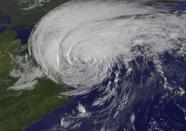Spare transformers: The answer to extreme weather risks?

That bad weather can damage property and lives is already known. It also has turned out to be the leading cause of power outages in the United States. And that, in turn, has helped spur the formation of a consortium of electric utilities that plans to create a national stockpile of hard-to-replace spare transformers.
The Lawrence Berkeley National Laboratory and Stanford University, in a study published last year based on the responses of 195 utilities, found that in the past decade or so, the average duration of weather-related customer interruptions increased by 260% to 370 minutes.
Climate Central, a science and journalism group, put out an earlier study saying the number of major weather-related outages doubled to more than 900 between 2003 and 2012.
"A significant number of the minutes that customers experience having their lights out are still the result of big storms," said Joseph Eto, the lead author and researcher at Lawrence Berkeley National Laboratory.
Calculating the cost of such events isn't easy, but a 2013 White House report concluded that weather-related blackouts cost the U.S. economy at least $18 billion and as much as $33 billion from 2003 to 2012.
Utilities, of course, spend tens of billions of dollars annually to harden, or upgrade, their distribution infrastructure.
Related: Utilities ratchet up spending on reliability
Beyond the impact on customers, power outages due to adverse weather can be expensive for utilities in a couple of ways.
First, there are the direct costs associated with damaged facilities. For example, Hurricane Katrina damaged all but three of Mississippi Power's transmission lines. In addition, 65% of the company's total distribution facilities were damaged.
In the absence of immediate government assistance, the company deployed an army division's worth of personnel to restore power and provide medical assistance. The total repair costs for the power outage that resulted from Katrina are estimated to be $300 million, according to Bill Snyder, a spokesman for the company.
Second, power outages can also translate into a number of ancillary, though still direct, costs. For example, the largest winter storm ever to hit the Dallas area in December 2013 pressed 5,000 workers from Oncor Energy, the local utility supplier, to work 16-hour shifts to restore power to affected areas. The company was also forced to increase its tree-trimming budget to $35 million after a similar storm hit its services in 2014.
To counter the growing disruption to power supplies, power utilities have put a number of measures in place, including investing in all kinds of technology.
According to Geoff Bailey, spokesman at Oncor Energy, the company has increased its average projected capital expenditure budget to $1.5 billion a year through 2020 for such work. A lot of those dollars are spent on infrastructure improvements. But the company also has invested in communication technology to bolster customer service during outages. Bailey said the company provides updates to customers through multiple platforms, from social media to individualized text messaging, and other channels during outages.
Last year, the Texas-headquartered utility also proposed a grid integrated energy storage plan, which would entail the construction of a battery storage and microgrid system. According to Bailey, Oncor's goal in part was to spark a national dialogue about the role that battery storage can play in enhancing reliability. It has already implemented a pilot project that places storage on the grid at six test locations in south Dallas. Bailey said the test units saved an average of 57 minutes of outage time in 2015.
Mississippi Power constructed a new state-of-the-art operations center with its own emergency power system and water source as backup after Hurricane Katrina battered its operations. Snyder said the facility can operate for up to 72 hours "completely isolated" from all outside utility sources.
Spare transformers have also emerged as another potential way to address the problem. However, because most transformers are manufactured abroad, there is a considerable time lag involved in bringing them here.
According to Joydeep Mitra, a Michigan State University professor and utility reliability expert, it can take 18 months to up to two years to bring new transformers into the country.
That's why utilities are banding up together to create a consortium called Grid Assurance to buy spare mobile transformers, circuit breakers and other equipment. Last year, eight power companies, ranging from Duke Power Co. to Southern Power, came together on the project. The idea is that the reserve capacity enabled by these initiatives - stored at secured warehouses - can be immediately pressed into action in the aftermath of extreme weather.
The equipment also could be used in case of cyber and physical attacks, solar storms, electromagnetic pulses, earthquakes and other natural disasters.
Grid Assurance last month asked FERC to give it its blessing to move forward - including an assurance that utilities can recoup the cost of purchasing spare service and parts from the consortium. It hopes to hear back in the next few weeks.
Weather-related outages will, of course, always remain part of life for utilities. "Unless you live in the Southwest United States or in a desert, a part of your distribution line will always pass through wooded areas (or come in contact with trees)," said Mitra.
"And there is always tension between customers and electric utilities regarding cutting down of trees," he said.
Even with a smart grid, the ongoing replacement of coal- or gas-fired plants with less-reliable renewable sources such as wind also will pose reliability challenges.
http://www.energybiz.com/article/16/01/spare-transformers-answer-extreme-weather-risks